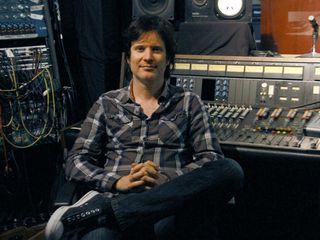
Studio Tour: Hollywood's Swing House Studios in pictures
When producer Jack Douglas and Aerosmith were looking for a studio to record guitar overdubs, vocals and additional live tracks for the band's recent album, Music From Another Dimension!, they didn't have to look too far: Warren Huart, engineer on the project, had just the place – his own Swing House Studios.
Swing House, which opened its doors 15 years ago, is a sprawling, multi-room facility located in the heart of Hollywood. Operating as both a rehearsal and recording studio, it has played host to artists such as Augustana, Marilyn Manson, Red Hot Chili Peppers, Shakira, The Fray, Band Of Horses, Iggy Pop and Maroon 5.
In the following photo gallery, Huart, who also doubles as producer for many acts, shows us around Swing House Studios (not to mention a quick peek inside his personal home recording space, Spitfire). The guided tour includes an extensive look at the outboard equipment that was used during the Aerosmith sessions.
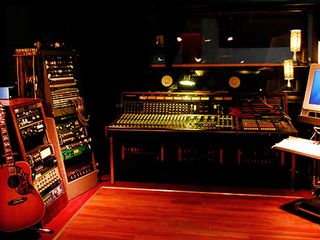
API Room
"This is the main control room attached to the Blue Stage where we tracked Aerosmith live, did overdubs and some other things," says Huart. "Off to the right hand side are two overdub rooms."
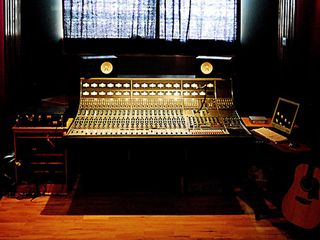
Neve Control Room
"This room houses an 8058, which we used to do some overdubs and editing. Joe Perry recorded his first live acoustic and vocal demo for Oasis, a song he wrote for his wife, Billie, in this room.
"Other times, we would use the room to listen to roughs or playbacks. The room is very neutral sounding, having been originally designed as a mastering suite."
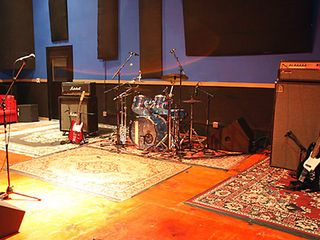
Blue Stage
"This is the main tracking room where the band recorded live. We cut basics on several songs here live. Joey used my blue Ludwig Vistalite, which is my main recording kit. There is a sound lock, where we put Brad's guitars, and the overdub room to right housed Joe's amps.
The sound lock between the overdub room and the Blue Stage had an Ampeg B15 for Tom's bass. Almost all the vocals for the album were cut here. We had the assistants make an iso booth in the middle of the room.
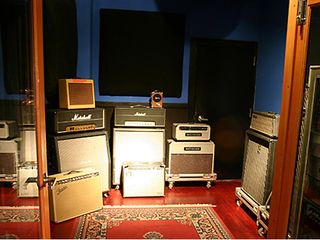
Overdub Room
"This is where we put Joe's amps while live tracking. Also, we had one of his amps here during overdubs, as well as a 4x12 out in the live Blue Stage room. The Blue Stage was miked for ambience to preserve the overall room sound that Jack wanted to maintain a la Rocks."
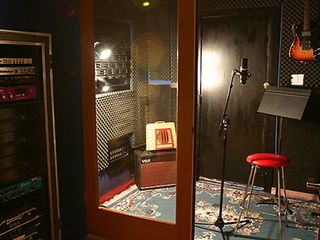
Vocal Booth
"This had small amps for Joe, which were isolated from the other amps and live room."
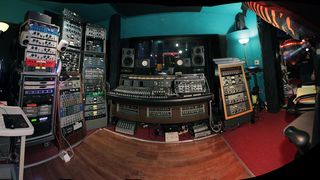
API Room - panorama shot
“You can see the Genelec monitors. We have them everywhere. They’re fantastic.”

Rack gear - one
Retro Sta-Level. That's a reissue of a Gates Sta Level. “We used that on Tom’s bass DI after an Ampeg mic preamp. It’s beautifully made.”
Retro 176 Limiting Amplifier. “A reissue of a Urei tube 1176 compressor. What’s interesting about this is, it has a high-pass filter. If you wind that up, it allows 300 Hz and below to go through and not get compressed. So it’s only compressing 300 Hz and above. It’s almost an EQ. When working with Joe on overdubs, we were able to bring all of the bottom end into his guitar tone. This was a huge part of his sound.”
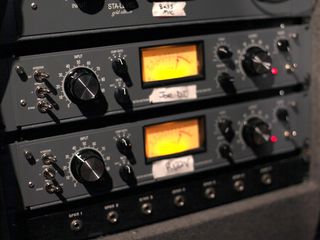
Rack gear - two
Two Retro 176s. “The bottom one was used on an amp in the large live room. The ‘R 122V' refers to the Royer 122V mic, which is tube version of their R 122 ribbon mic. It’s phenomenal. Tons of bottom end.”
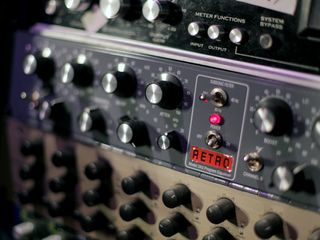
Rack gear - three
Retro 2A3 Dual Program EQ. “The Retro 2A3 stereo tube EQ is based loosely on a Pultec. Pultec is passive EQ, which means you don’t get as much boost and cut as you do with active EQ, but it doesn’t affect the sound as much in a negative way. It tends to be more transparent.”
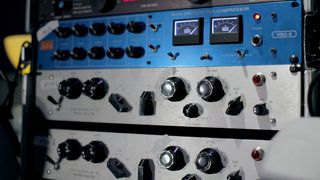
Rack gear - four
Vertigo VSC-2 Quad Discrete Compressor. “That was our master buss compressor. It’s fantastic. What I really like about it is the way low frequencies can pass through without being compressed. It adds a lot of warmth to the mix.”
Two Pulse Techniques EQs by Steve Jackson. “Steve owns the rights to make Pultecs. We used these on the master buss.”
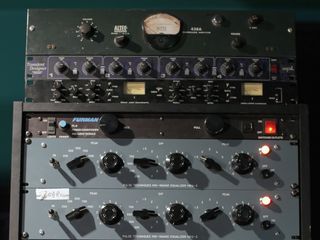
Rack gear - five
Altec 438A Mic Pre/Compressor. “I use it as something of a special effects compressor, because it has a very slow release time. It takes ages for the signal to pop back, so you wouldn’t use it on fast, percussive things; you just use it when you want to suck everything down. It’s very Beatle-ly – they used them in Abbey Road.”
SPL Transient Designer. “It’s great for shaping the attack and the kick on drums.”
Trident Stereo Compressor. “I use that for some special effects stuff and a little overcompression.”
Furman Power Supply.
Two Pulse Techniques MEQ-5 Tube EQs. “I was using those for guitars to add some midrange.”
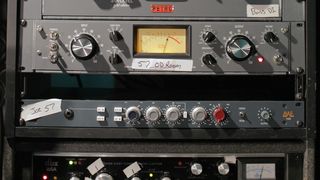
Rack gear - six
BAE 1028 Mic Preamp. “I was using those a lot on Joe’s guitars. It’s like a souped-up version of a Neve 1073. What’s great about it is, it has some additional EQ points, if you just want to get in there and do some fun EQing.”
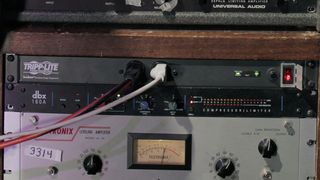
Rack gear - seven
Tripp-Lite Power Supply.
Dbx 160 A Compressor/Limiter. “I use that on the ‘Kick In’ – the microphone inside of the kick drum.”
Teletronix Leveling Amplifier LA-2A. “That’s for tambourines and percussion.”
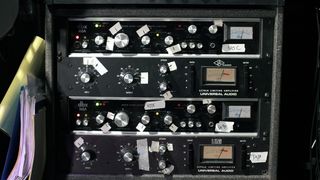
Rack gear - eight
The vocal chain. Two dbx 165A Compressors and two Universal Audio 1176LN Limiting Amplifiers.
“I would come out of a BAE 1073 mic pre – Steven Tyler recorded with a Neuman U47 and a U48 – and split the signal into two separate compression chains, the top and the bottom. I parallel compressed, which means that the softer words were compressed with the top chain, and the harsher stuff went through the bottom, on which the thresholds were set a little higher. That was molded back into one input.”
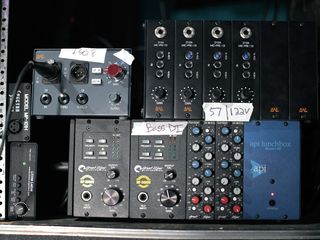
Rack gear - nine
Top left: Spectra Sonics Mic Preamp model MP 101H. “It’s modeled after the original console in the Record Plant.”
Top middle: BAE Mic Preamp. “That’s a very nice piece of equipment, because it’s a Neve mic preamp in a box. I took that into the live room to track the full band, which we did a lot on the record. Tom Hamilton would plug into this for his DI, and we’d send a line level cable back to tape from the room. That’s a pretty awesome way of doing things. To have a mic preamp right next to the player is pretty special.”
Top right: BAE 312 Mic Preamps. “These were Joe’s guitars – a SM 57 on an amp in the live room and a Royer 122V, also in the live room.”
Bottom left: Little Labs Analog Phase Alignment Tool. “There were plenty of times when I’d run a minimum of two microphones on a cab, and other times I ran two or three cabs on one guitar sound – two or three guitar amps with their own cabs in the live room. So when you have multiple mics on multiple amps at the same time, they’re not always moving air together. This allows you to adjust the phase on the amps and pull everything in.”
Bottom middle: Great River Preamps. “I had some fun with those. We used them for bass DIs. There wasn’t one bass sound, there wasn’t one guitar sound – we tried different things. On the day we took these pictures, we were using these preamps on the bass DI.”
Bottom right: “Great River Harrison EQs. “I used those for mixes on the rooms to scoop out some low-mids and do some high-mid boosting.”
Bottom extreme right: API Lunchbox. “That’s a little rack that you can put mix preamps into.”
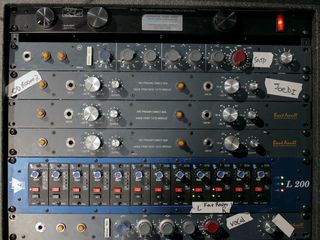
Rack gear - ten
BDL power supply.
BAE 1064 Mic Preamp. “I was using that on the snare. That’s in British Naval Blue, the color used to paint battleships. When Neve started his company, he needed to buy paint. He went to the government, and they said, ‘We have tons of this naval blue. You can buy it at a tenth of the price.’ That’s why Neves are a gray-blue color.”
Three BAE Neve 1072 Mic Preamps. “These are made from Neve line amps converted into mic preamps. We would often distort Joe’s mic DI with these. He has a massive collection of pedals. One is called a B&M – that’s for Barnes & Mullins in England – and we would turn it up and plug it into the Neve, and we’d just distort it like mad. The result would be an incredible fuzztone.”
API Rack. “For Joe’s room tone, we used a pair of those, hence ‘Far Room.’”
BAE Neve 1073 Mic Preamp. “That was set to do a very driven vocal, judging from the setting on the gain.”
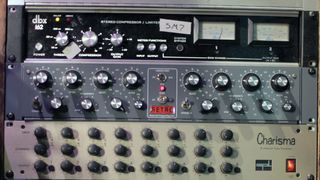
Rack gear - eleven
Dbx 162 Stereo Compressor/Limiter. “That was for an SM7 on a vocal.”
Retro Tube EA.
SPL Eight-Channel Charisma. “Basically, it’s a distortion unit. It adds harmonics and screws things up. It makes things wrong in a good way.”
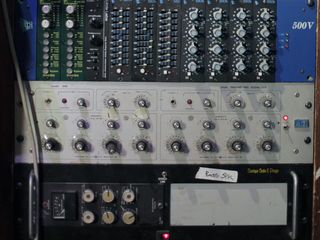
Rack gear - twelve
API Rack. “In it is a pair of Daking compressors, which we used on room compression, along with a VOG – Voice Of God – which boosts the bass. Then there are three API 560b Graphic EQs. I like them on kick and snare. There are four 550b EQs, which I would use on mixing.”
Urei 546 Dual Parametric EQ. “I used the left-hand channel to shape the ‘Kick In’ microphone. I bought it on $3.67 on eBay back when they first started and you could actually buy things for a bargain. It’s holding on for dear life.”
Calrec CL1204. “A beautiful piece of equipment. That’s basically a brick wall limiter, a look-ahead compressor. It delays the signal very slightly and doesn’t allow any peaks to go through. I used that to record a bass speaker, in this case a 15-inch speaker miking another 15-inch speaker. That produces ultra-lows, and to control it I use the Calrec.”
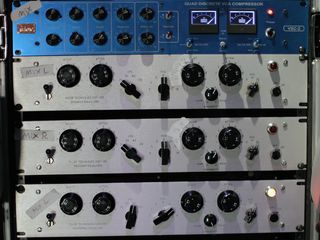
Rack gear - thirteen
Vertigo VSC-2 Quad Discrete Compressor. “It’s the main mix-buss compressor that we used. It’s got dbx VCAs in it, the original ones, which everybody loves. It’s an American-sounding product controlled by Germans – how crazy is that?”
Three Pulse Techniques EQP-1AE Program Equalizers. “I’d use them on the mix-buss and bass guitars and all kinds of shenanigans.”
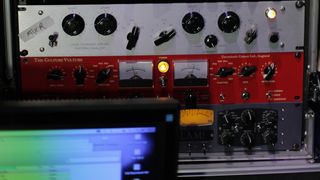
Rack gear - fourteen
Pulse Techniques EQP-1AE Program Equalizers.
The Culture Vulture. “Another kind of harmonic distortion device, which we tried out on various things. If you want to mess things up and screw around with them, you can put a little of that on. I tend not to put a while signal through it; I put a piece of a signal, crush it, break it apart and trample it, and then I bring it back into the main signal.”
Manley Slam! Stereo Mic Pre/Limiter. “We used that for extreme limiting.”
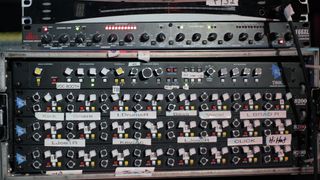
Rack gear - fifteen
“Our monitoring system. I have an old API, which has a 16-buss monitoring system – totally cool for Pro Tools. But because we were using CLASP, we needed this API monitor section to allow us to have 24 outputs.”
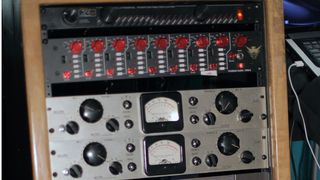
Rack gear - sixteen
Phoenix Audio DRS-8 Mic Preamp. “I often used that on stereo piano and overheads.”
Crown Mic Preamps. “They actually came out of a tape machine, and they sound fantastic.”
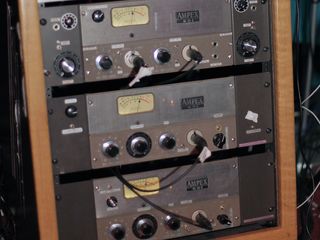
Rack gear - seventeen
Ampex 601 Mic Preamps. “They’re all from reel-to-reel tape decks. Pretty cool. Two of them have been modded to have LA-2As in them. I often use them on bass DIs.”
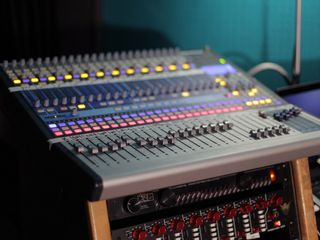
PreSonus Mixer
“That’s what we used to sub-mix all of our headphones. The PreSonus fed the Aviom headphone system.”
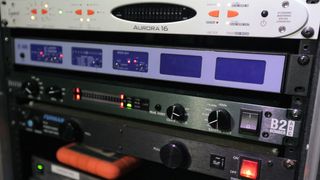
IOS station
Aurora 16 AD/DA Converter. “The I/O that we were using. I love it because it’s 16-in/16-out. I’ve got a pair of them, so that’s 32-in/32-out.”
Lavry Blue MDA-824 AD/DA Converter. “Great for mixing. I mix everything to the Lavry Blue.”
B2 Bomber Analog/Digital Converter. “Another I/O – very warm, sounded great on certain instruments.”
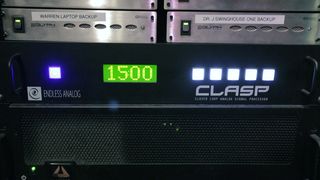
CLASP unit
“We used CLASP everywhere – all the basic tracking, the drums, the bass and most of the guitars. It’s a big part of the sound of the record. It allowed us to make a tape record but have the abilities to choose takes digitally.”

Spitfire Studio
Spitfire, located in Laurel Canyon, is Huart's personal studio. It houses an SSL 4000 G and a large collection of vintage equipment, such as Pultecs, API EQs and 1176s. There is a drum tracking room, which Huart records drums in using Pheonix Mic Preamps.
Hurt mixed half of Music From Another Dimension! at Spitfire, as well as many other projects, such as Cher Lloyd and Better Than Ezra.

Joe is a freelance journalist who has, over the past few decades, interviewed hundreds of guitarists for Guitar World, Guitar Player, MusicRadar and Classic Rock. He is also a former editor of Guitar World, contributing writer for Guitar Aficionado and VP of A&R for Island Records. He’s an enthusiastic guitarist, but he’s nowhere near the likes of the people he interviews. Surprisingly, his skills are more suited to the drums. If you need a drummer for your Beatles tribute band, look him up.
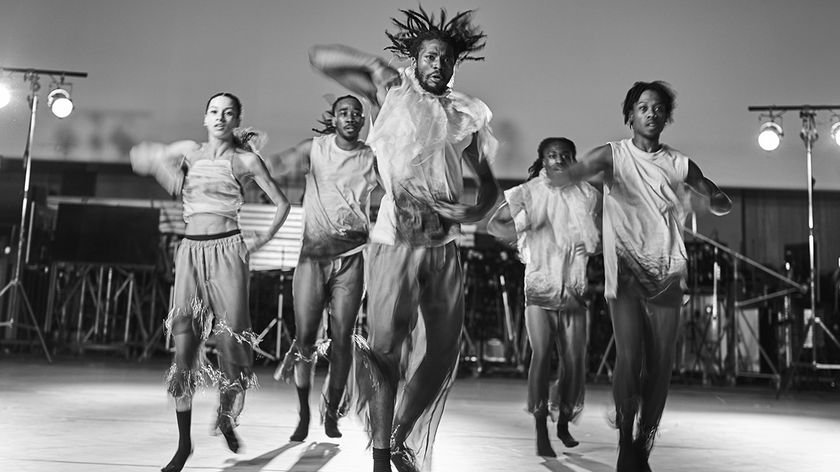
Refurbished Abbey Road Studio One reopens with evening of "boundary-pushing expressive dance" that blends styles from ballet to hip-hop and krump - and a new mixing desk

“I was like, ‘man - this is the energy’”: Billie Eilish’s mix engineers reveal the star's “favourite part” of her smash hit, Birds Of A Feather

Refurbished Abbey Road Studio One reopens with evening of "boundary-pushing expressive dance" that blends styles from ballet to hip-hop and krump - and a new mixing desk

“I was like, ‘man - this is the energy’”: Billie Eilish’s mix engineers reveal the star's “favourite part” of her smash hit, Birds Of A Feather









